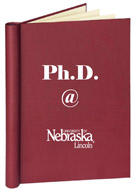Graduate Studies, UNL

Dissertations and Doctoral Documents, University of Nebraska-Lincoln, 2023–
First Advisor
Jinying Zhu
Degree Name
Doctor of Philosophy (Ph.D.)
Department
Civil Engineering
Date of this Version
8-2024
Document Type
Dissertation
Citation
A dissertation presented to the faculty of the Graduate College of the University of Nebraska in partial fulfillment of requirements for the degree of Doctor of Philosophy
Major: Civil Engineering
Under the supervision of Professor Jinying Zhu
Lincoln, Nebraska, August 2024
Abstract
The thermal modulation method is a recently developed nonlinear ultrasonic technique for evaluating material damage. This method utilizes thermal strain changes resulting from temperature variations to excite the nonlinear behavior of materials and modulate high-frequency ultrasonic waves within them. Its working principle suggests significant potential for application in large-scale concrete structures and in-situ monitoring of real structures. Despite numerous laboratory demonstrations of its effectiveness, several gaps remain before it can be applied to in-service large concrete structures.
This study investigates the potential of the thermal modulation technique for evaluating concrete structures in ambient conditions, addressing key uncertainties for practical implementation. These uncertainties include the temperature ranges affecting the effectiveness of the method and the concrete material hysteresis under extensive thermal cycling. A comprehensive long-term ultrasonic monitoring study was designed and executed to assess the efficacy of the thermal modulation method in real-world scenarios.
The research began with a 200-day laboratory experiment monitoring alkali-silica reaction (ASR) damage in small concrete prisms (3 in × 3 in × 11.25 in). This experiment aimed to reevaluate existing non-destructive testing methods, including thermal modulation, and equip the researcher with skills and experience for long-term ambient environment testing on large ASR concrete specimens.
Additionally, larger concrete specimens (12 in × 12 in × 44 in) with existing ASR development were continuously monitored using ultrasound in an uncontrolled ambient environment in Omaha, Nebraska, over 17 months, covering a wide range of temperatures. This study examined the relationship between ultrasonic wave velocity and ambient temperature in ASR concrete specimens under hundreds of ambient thermal cycles in various temperature ranges. The results validated the feasibility of thermal modulation for differentiating ASR damage levels in all seasons, regardless of temperature variations and uncontrolled ambient conditions. Moreover, the nonlinear parameters from thermal modulation were found to be larger in colder temperature ranges (< 15 C) compared to warmer ranges (> 20 ◦C). A larger material hysteresis was observed in warmer temperature ranges, resulting in differences in nonlinear parameters extracted during cooling and heating processes, while minimal differences were observed in cold temperature ranges.
Furthermore, convolutional neural networks (CNNs) were employed for concrete damage assessment, using both 1D waveforms and 2D B-scan images for classification. The study demonstrates the superiority of the 2D CNN model, which incorporates waveform information and ultrasonic response to temperature fluctuations, thereby enhancing data processing capabilities for the thermal modulation method.
The findings of this study bridge the gap between laboratory efficacy and real-world applicability of the thermal modulation method, advancing this newly developed technique significantly closer to practical real-world applications.
Advisor: Jinying Zhu
Recommended Citation
Tang, Yalei, "Long Term Ultrasonic Monitoring and Machine Learning Investigation of Micro-Crack Damaged Concrete" (2024). Dissertations and Doctoral Documents, University of Nebraska-Lincoln, 2023–. 179.
https://digitalcommons.unl.edu/dissunl/179


Comments
Copyright 2024, Yalei Tang. Used by permission